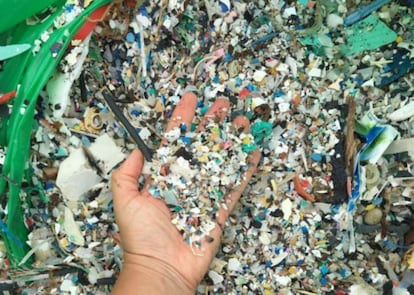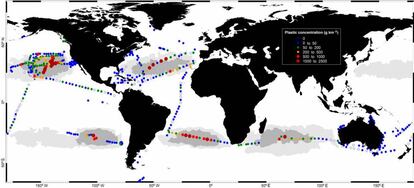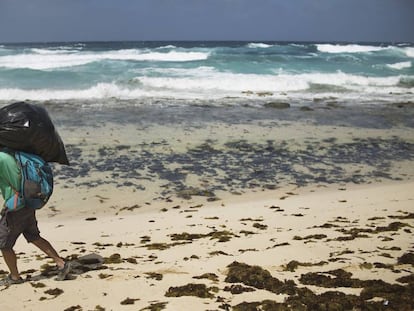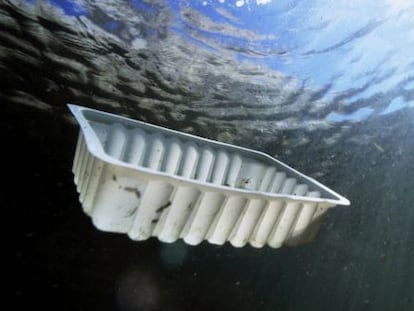Video showing devastating plastic pollution on Tenerife beach goes viral
A conservationist has captured images of the waste covering the shore of the Canary Island. Currents in the area act as a garbage collector for what washes in from the North Atlantic

There is enough plastic in the Pacific Ocean to cover the surface of France three times over, according to a 2018 study published in Nature magazine. Known as the “Great Pacific Garbage Patch,” this mass of floating plastic is made up of the remains of tons of bottles, plastic cutlery and plates. A large amount of this plastic ends up on the coast.
😭😭😭😭😭😭😭😭😭 y esto aquí mismo en Tenerife , como dice la chica no hace falta irse a Indonesia 😥😥😥😥
Posted by Saul Garcia Rodriguez on Monday, March 25, 2019
A video recorded on March 24 highlights the shocking extent of plastic pollution on a beach in Tenerife, one of Spain’s Canary Islands. Filmed at Playa Grande beach near the coastal town Poris de Abona, the video shows the sand covered in small bits of plastic. The images went viral on WhatsApp and caused a frenzy on social media, with copies of the video shared thousands of times via Facebook and Twitter.
The video was filmed by María Celma, the founder of the ocean clean-up group Océano Limpio Tenerife (Clean Ocean Tenerife). “A clean-up had been arranged by another organization that day and when I saw the beach like that, I decided to make the video,” she tells Verne by telephone. In the video, she can be heard saying that you don’t need “to go to a beach in Indonesia” to find a coast covered in plastic. “If I feel frustrated and desolate, and when I see the beach in this state, I show it,” she says. “Hopefully more people will see it and feel the same and be more aware of the problem.”
Celma says that there was a lot of plastic the day she made the recording but explains it is hard to find a day when Playa Grande is ever completely clean. “Whatever day you go, you find plastic,” she explains. “Even when we finish cleaning up the beach, it’s not clean. We don’t cover enough.”
El pasado fin de semana el grupo R&S Océano Limpio Tenerife participó en una limpieza en una de las playas de la zona....
Posted by Raíces & Brotes España on Tuesday, March 26, 2019
Last weekend, the group R&S Clean Ocean Tenerife participated in a clean-up at one of the beaches in the area. The result speaks for itself. Microplastics are invading everything. Reduce your footprint, reuse, recycle.
Playa Grande is far from the only beach on Tenerife with a plastic-pollution problem. “This beach [Playa Grande] stands out for two reasons: because a lot of plastic washes up and because it is very visual,” Celma explains. “Given it is a sandy beach, all the plastic is easily seen. But there are rocky beaches that are much dirtier but you only realize this when you lift up the rocks.”
The plastic waste could have spent years in the sea and traveled thousands of kilometers before washing up on the beach. “It is mostly dragged in by the currents,” explains May Gómez, a biology professor at the University of Las Palmas of Gran Canaria (ULPGC) and researcher at EOMAR, a group that focuses on the ecophysiology of marine organisms.
“The Canary Islands form a natural barrier against the Gulf Stream and its offshoot, the Canary Current, which means it acts like a garbage collector for what is found in the North Atlantic,” the researcher tells Verne. In this map, published by the scientific magazine Proceeding of the National Academy of Sciences, you can see how currents drag plastic across the world.

Microplastics
Once Celma and the rest of the volunteers finish cleaning up the beach – they can collect up to 30 kilos of plastic – they leave the bags of plastic next to the garbage container. The plastic cannot be recycled because most of the waste that washes up is microplastics, tiny pieces that measure less than five millimeters.
A lot of plastic cannot be recycled, either because of its composition or its size. The machine that separates elements in recycling plants cannot separate small utensils such as knives and forks, let alone small fragments of plastic.
Microplastics are either created to be small (many are used in cosmetics, for example) or have broken down from larger containers. According to various studies, the average adult can ingest between 2,000 and 11,000 microplastics a year. The impact of this on health is still being studied.
Meanwhile, the problem of marine plastic pollution is only getting worse. In 2017 alone, eight million tons of plastic ended up in the sea. Both governments and big businesses are trying to find solutions to minimize the ecological impact of plastic waste on the future but there are also things you can do to limit your plastic consumption. Here are some ways you can help:
- Shop with a reusable bag
- Use bars of soap instead of handwashes
- Drink tap water from a reusable water bottle
- Buy products such as cereals in bulk and not in plastic packaging
- Choose natural materials
- Avoid single-use crockery items
- Don’t use plastic straws or inflatable balloons
If we don’t take action now, by 2050 there will be more plastic in our oceans than there are fish.
English version by Melissa Kitson.
Tu suscripción se está usando en otro dispositivo
¿Quieres añadir otro usuario a tu suscripción?
Si continúas leyendo en este dispositivo, no se podrá leer en el otro.
FlechaTu suscripción se está usando en otro dispositivo y solo puedes acceder a EL PAÍS desde un dispositivo a la vez.
Si quieres compartir tu cuenta, cambia tu suscripción a la modalidad Premium, así podrás añadir otro usuario. Cada uno accederá con su propia cuenta de email, lo que os permitirá personalizar vuestra experiencia en EL PAÍS.
¿Tienes una suscripción de empresa? Accede aquí para contratar más cuentas.
En el caso de no saber quién está usando tu cuenta, te recomendamos cambiar tu contraseña aquí.
Si decides continuar compartiendo tu cuenta, este mensaje se mostrará en tu dispositivo y en el de la otra persona que está usando tu cuenta de forma indefinida, afectando a tu experiencia de lectura. Puedes consultar aquí los términos y condiciones de la suscripción digital.











































